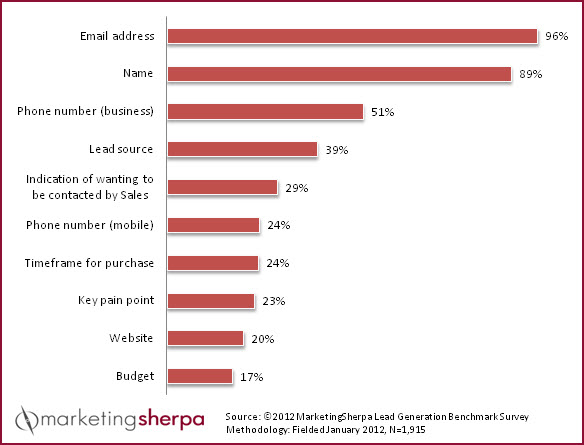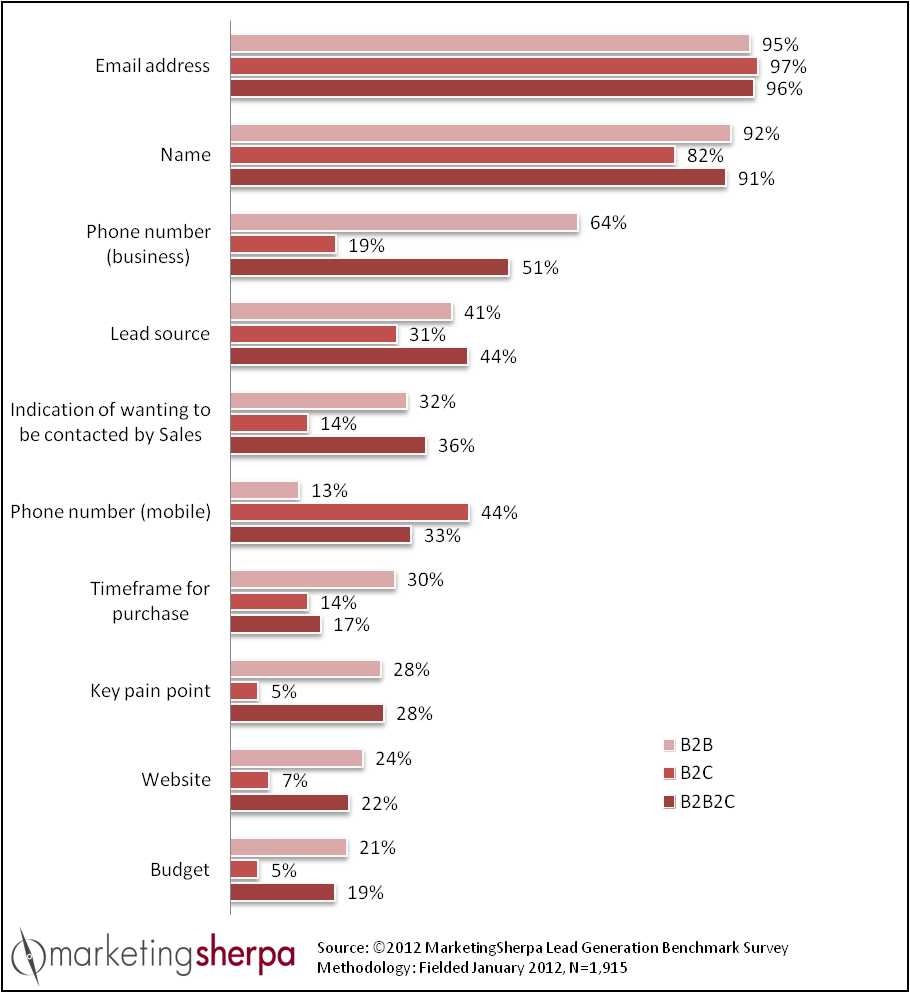Lead Generation: 23% of marketers consider key pain point an important form field
In the 2012 Lead Generation Benchmark Report, we asked 1,915 marketers which lead gen form fields were most important to them. Here’s what they had to say …
Q: Please select the most important fields you need to collect from your leads on lead generation forms.
Interestingly enough, most of the discussion about this chart surrounded one of the lesser-used form fields – key pain point.
How should you ask for key pain points?
“Do people actually label the field as ‘key pain point’?” asked Katrina Denk, Marketing Manager, Strata Company. “I would find using that terminology odd when it comes to a customer-facing form. If you request this info but don’t use that terminology, what do you use?”
Bob Scheier, principal, Bob Scheier Assosciates, had a few suggestions:
- Top concerns when considering XYZ
- Top questions I would ask before choosing an XYZ
- Greatest challenges I am facing in XYZ
A few more, slightly out-of-the-box ideas, based on MarketingSherpa case studies:
- Interactive Registration Forms – Based on their answers, each respondent is then offered more report and/or product info based on their pain points and specific needs. Since the offers are highly targeted, respondents are more likely to accept. (“Interactive Registration Form Gets 300% More Completions Than Regular Sales Lead Forms“)
- Behavioral Data – And, perhaps, don’t even ask this question on your forms. Look to buyer behavior to identify their pain points. Elsevier used prospect behavior to help determine which triggered emails to send. As the prospect moved through the buying cycle to the consideration stage, the content shifted and expressed that Elsevier also understood specific problems or pain points the recipient might have, and let them know the company can solve those issues with its products. (“Multichannel Marketing: Combining email and content marketing leads to 35% conversion rate for Elsevier“)
Additionally, Bob had an even more creative idea …
“[I] am wondering if anyone has had more success making the ‘pain point’ a mini-survey question and promised to send all respondents the results, making it less of a salesly question and offering respondents some value for giving up their info?”
“Pose this as a poll so that prospects could see what their peers are thinking and whether they’re as far along implementing technologies as their peers,” Bob suggested.
I think that’s a great idea, Bob, and I wonder if anyone else has tried it. The closest I’ve seen is using survey data in content marketing, like in this blog post: “Content Marketing: Are users more likely to convert with only one article featured or multiple articles?”
And when should you not ask?
Of course, only 23% of marketers consider key pain point an important lead gen form field, and for good reason.
“This presumes that the prospect has a pain point and an immediate need, said Tommy Landry, founder, Return On Now. “Great field for down-funnel leads, but avoid it for early-stage leads.”
Of course, this isn’t merely a philosophical question. After all, less form fields usually equals more form fills.
“It would be interesting to correlate fields on landing page forms with completion rates,” said Prugh Roeser, founder, LeadMaker.
While we don’t have that specific information, we do know that it is worthwhile to test lead form length. And when you do, you’ll likely find that the longer the form (and, especially, the more friction in the form), the lower the conversion rate. For example, Marketo discovered that a shorter form yielded a 34% higher conversion rate in this test.
Aside from the tendency of lower conversion rates in longer forms, Prugh went a step further and questioned whether you’re getting what you really want from prospects who do actually take the time to complete the longer form.
“Many marketers try to make these responses mandatory to get as much BANT (Budget, Authority, Need and Timescale) data upfront as possible. But this means the completion rates should also be broken out by rough ‘now’ versus ‘later’ responses to gauge how much people are just trying to get through the form.”
B2B vs. B2C marketers
Prugh also discussed the mix of marketers who filled out the benchmark survey, and how they might have different goals with their lead forms.
“I took your point about the drop-off after the first two most important fields, but I wonder if that may be due to what appears to be a mix of B2C and B2B responses. I couldn’t find whether the responders were B2C or B2B or both, but judging from the fields that made it to the chart, it looks like they were both.”
“This is important,” Prugh said, “since there’s usually more resistance in B2C settings to providing anything beyond basic information. In B2B, it’s more agent-of-a-company to agent-of-a-company, and individuals tend to accept the need to profile themselves since their interest is usually driven by their jobs.”
As you can see from the below data broken out by primary market from the MarketingSherpa 2012 Lead Generation Benchmark Report, Prugh has a point. B2B marketers clearly feel that they need (and, presumably, can get their prospects to provide) significantly more information. The one notable outlier field where B2C marketers are more demanding is mobile phone number.
Q: Please select the most important fields you need to collect from your leads on lead generation forms.
If you would like to feature your tips and analysis about MarketingSherpa research in a future blog post, sign up for the MarketingSherpa Chart of the Week newsletter and provide your insights to a chart that resonates with you.
Related Resources:
Managing Web Forms For Conversion and Lead Quality
List Building: The four questions every email capture page must answer
Orphan Forms: Marketing 101 change drives 32% increase in form completions
Lead Gen Form Optimization: Why a lower conversion rate can be a good thing
B2B Lead Gen: A/B split test helps increase quote requests 262%
Categories: Lead Generation contact forms, form optimization, lead generation, list building, reducing friction and anxiety, web forms











